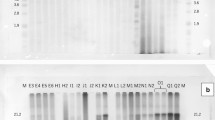Abstract
The telomere sequence type (TTAGGG)n is known to be distributed in various phyla in the Animalia and in Mastigophora (Protista). However, the telomere type of Porifera (sponges), a phylum comprising the lowest multicellular animals, has not been reported. In this study, we examined the three sponge species Leucetta chagosensis, Halichondria japonica, and Halichondria panicea for the presence of the telomere type (TTAGGG)n by fluorescence in situ hybridization (FISH). The oligonucleotide probe (TTAGGG)7 clearly displayed signals on the interphase nuclei of all three sponges. In contrast, the (TTAGG)7 probe, which has one base fewer than (TTAGGG)7, did not display the signals. These results suggest that the telomeres of the three sponges consist of (TTAGGG)n, which is identical to the sequence type found in many higher multicellular animals and in Mastigophora. Additionally, this is the first study to reveal a telomere sequence type for Porifera. Moreover, these results suggest that Porifera are phylogenetically related to Mastigophora, and supports the general theory that Porifera evolved from Mastigophora. Further, this study strongly suggests that the origin of the (TTAGGG)n telomere sequence is to be found in a common ancestor of either the Bilateria and Porifera, or the Protista.
Similar content being viewed by others
References
Blackburn EH. Structure and function of telomeres. Nature 1991; 350: 569–573.
Meyne J, Ratliff RL, Moyzis RK. Conservation of the human telomere sequence (TTAGGG)n among vertebrates. Proc. Natl. Acad. Sci. USA 1989; 86: 7049–7053.
Wang Y, Guo X. Chromosomal mapping of the vertebrate telomeric sequence (TTAGGG)n in four bivalve molluses by fluorescence in situ hybridization. J. Shellfish. Res. 2001; 20: 1187–1190.
Sakai M, Okumura S, Yamamori K. Telomere analysis of pacific abalone Haliotis discus hannai chromosomes by fluorescence in situ hybridization. J Shellfish. Res. 2005; 24: 1149–1151.
Gallardo-Escarate C, Alvarez-Borrego J, Del Rio-Portilla MA, Von Brand-Skopnik E, Cross I, Merlo A, Rebordinos L. Karyotype analysis and chromosomal localization by FISH of ribosomal DNA, telomeric (TTAGGG)n and (GATA)n repeats in Haliotis fulgens and H. corrugata (Archeogastropoda: Haliotidae). J. Shellfish. Res. 2005; 24: 1153–1159.
Jha AN, Dominquez I, Balajee AS, Hutchinson TH, Dixon DR, Natarajan AT. Localization of a vertebrate telomeric sequence in the chromosomes of two marine worms (phylum Annelida: class Polychaeta). Chromosome Res. 1995; 3: 507–508.
Joffe BI, Solovei IV, Macgregor HC. Ends of chromosomes in Polycelis tenuis (Platyhelminthes) have telomere repeat TTAGGG. Chromosome Res. 1996; 4: 323–324.
Vitkova M, Krai J, Traut W, Zrzavy J, Marec F. The evolutionary origin of insect telomeric repeats, (TTAGG)n. Chromosome Res. 2005; 13: 145–156.
Okazaki S, Tsuchida K, Maekawa H, Ishikawa H, Fujiwara H. Identification of a pentanucleotide telomeric sequence, (TTAGG)n, in the silkworm Bombyx mori and in other insects. Mol. Cell Biol. 1993; 13: 1424–1432.
Muller F, Wicky C, Spicher A, Tobler H. New telomere formation after developmentally regulated chromosomal breakage during the process of chromatin diminution in Ascaris lumbricoides. Cell 1991; 67: 815–822.
Henderson E. Telomere DNA structure. In: Blackburn EH, Greider CW (eds). Telomeres. Cold Spring Harbor Laboratory Press, New York, NY. 1995; 11–34.
Arai K, Naito F, Sasaki H, Fujino K. Gynogenesis with ultraviolet ray irradiated sperm in the Pacific abalone. Nippon Suisan Gakkaishi 1984; 50: 2019–2023.
Mendez J, Pasantes JJ, Martinez-Exposito MJ. Banding pattern of mussel (Mytilus galloprovincialis) chromosomes induced by 2 × SSC/Giemsa-stain treatment. Mar. Biol. 1990; 106: 375–377.
Petracek ME, Lefebvre PA, Silflow CD, Berman J. Chlamydomonas telomere sequences are A+T-rich but contain three consecutive G-C base pairs. Proc. Natl. Acad. Sci. USA 1990; 87: 8222–8226.
Hyman LH. Origin of the Metazoa. In: Sinsheimer RL, Pittindrigh CS, Bullock TH, Brenner S (eds). The Invertebrates: Protozoa Through Ctenophora Vol. 1. McGraw-Hill, New York, NY. 1940; 248–253.
Haeckel E. The gastraea-theory, the phylogenetic classification of the animal kingdom and the homology of the germlamellae. Q. J. Microsc. Sci. 1874; 14: 142–165.
Wainright PO, Hinkle G, Sogin ML, Stickel SK. Monophyletic origins of the Metazoa: an evolutionary link with fungi. Science 1993; 260: 340–342.
Author information
Authors and Affiliations
Corresponding author
Rights and permissions
About this article
Cite this article
Sakai, M., Okumura, SI., Onuma, K. et al. Identification of a telomere sequence type in three sponge species (Porifera) by fluorescence in situ hybridization analysis. Fish Sci 73, 77–80 (2007). https://doi.org/10.1111/j.1444-2906.2007.01304.x
Received:
Accepted:
Issue Date:
DOI: https://doi.org/10.1111/j.1444-2906.2007.01304.x




